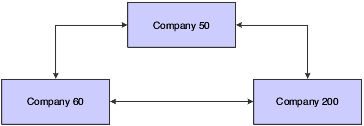Example: Journal Entry Among Three Companies
This example shows how the system creates entries when you enter a journal entry among three companies. In this example, company 200 accrues liabilities incurred by companies 50 and 60, as illustrated:

For the journal entry, assume that the business unit on the balance sheet matches the company number. You enter a journal entry that involves more than two accounts:
Document |
Company |
Account |
Description |
Debit |
Credit |
|---|---|---|---|---|---|
JE 6000 |
50 |
50.8150 |
Expenses |
300 |
Blank |
JE 6000 |
60 |
60.1800 |
Prepaid Expenses |
200 |
Blank |
JE 6000 |
200 |
200.4110 |
Accounts Payable |
Blank |
500 |
The company on the first line of the journal entry determines the hub company. When you post the entry, the system automatically generates these intercompany entries:
Document |
Company |
Account/Sub/Type |
Description |
Debit |
Credit |
|---|---|---|---|---|---|
AE 6000 |
60 |
60.1291/00000050/A |
Intercompany Receivables/Payables |
Blank |
200 |
AE 6000 |
50 |
50.1291/00000060/A |
Intercompany Receivables/Payables |
200 |
Blank |
AE 6000 |
200 |
200.1291/00000050/A |
Intercompany Receivables/Payables |
500 |
Blank |
AE 6000 |
50 |
50.1291/00000200/A |
Intercompany Receivables/Payables |
Blank |
500 |
The second and fourth rows are entries to the hub (company 50) from companies 60 and 200.